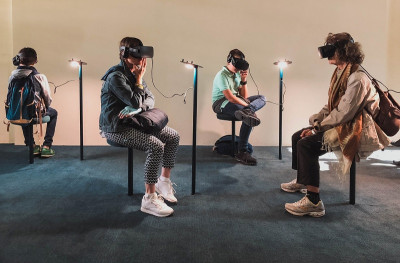Part 1: Crystal-gazing into the Metaverse in 2023 - Achieving scale & biz implications
The year 2022 can easily be called the year of the Metaverse – with this digital universe dominating conversations and brand explorations. While brands, artistes, influencers, tech frontrunners, gaming companies, among others, were seen to increasingly up their presence and engagement with the Metaverse, experts believe they have only touched the tip of the iceberg. As the year draws to a close, there is great excitement about further exploring and leveraging the immense potential and possibilities that Metaverse offers in 2023.
ALSO READ: Metaverse to contribute $3 trillion to global GDP by 2031
In this two-part series, Adgully gazes into the crystal ball to decode the growing march of the Metaverse and its implications across the industry.
Experts are unanimous in their view that 2023 will be a decisive year as the Metaverse is poised to shape up at scale.
“There is no doubt the metaverse is here to stay, and we can expect to see many changes to our lives in the next few years,” says Devang Mundhra, Chief Technology and Product Officer at KredX. He is certain that the foundation for the Metaverse will continue to shape up in 2023, and the rise of virtual worlds will likely affect our online experiences of gaming, working, travel, shopping and more.
According to Mundhra, the concept is predicted to add $5 trillion to the value of the global economy in the coming few years, and 2023 is expected to be a defining period in that regard.
“Moreover, as per recent reports, people are spending around seven hours on the Internet already, which is one third of their lives; so they are for all practical purposes already living in a parallel universe talking to different people compared to where they are physically, and representing themselves differently. So, they are already in a different mindset then, that is now getting formalised as Metaverse,” he adds.
Furthermore, he says that with any emerging technology, the headsets and the new-age technologies that strengthen the Metaverse are expected to eventually become more affordable and accessible.
“This ecosystem also promises to provide platforms, tools, and entire virtual worlds where business can be done remotely, efficiently, and intelligently. It will become fundamental in the future of working, gaming, eating, etc.; but more importantly, the Metaverse economy will become as important as the real-world,” notes Mundhra.
“Metaverse was the buzzword in 2022, with its popularity only increasing as major Web2 firms entered the sector,” states Kaavya Prasad, Founder, Lumos Labs. In terms of mass adoption, she points out, there are still several factors that inhibit its ease of use, yet with over $120 billion in investments in the first five months of 2022, the experts of the space seem to be bullish. She predicts that for 2023, we can expect to see an increase in Metaverse use cases in gaming, investment, retail, education, service industries, etc.
“With virtual retail stores, virtual art galleries, independent metaverses, and more, we can expect increased immersive experiences in diverse sectors and new innovations that make the digital world simpler. The Web3 sector has been a major contributor to the Metaverse and we are bound to see the Web3 Metaverse grow as both developing industries have been welcoming innovations and new solutions consistently. Our Lumos Metaverse itself is gearing up with its MVP in the beginning of next year to ensure holistic opportunities are available for developers soon,” says Prasad.
Brands and marketers
We will see more brands and marketers adopting the Metaverse in a major way. Experts are positive about it. In 2023, the Metaverse will establish itself as the nexus of the new Internet of the people, says Dewang Mulani, Business Development, XP&DL and Metaform, the Web 3.0 agency of Zoo Media Network.
Mulani further notes that in the last couple of years, brands intended to leverage the Metaverse for the hype it enjoyed and a first-mover advantage. He predicts that in the forthcoming years, brands will consciously invest in translating their brands into experiences that consumers can interact with.
“Fellow marketing professionals, I reckon, will take to defining Metaverse goals for brands and evaluating brand and community fit. More importantly, in my opinion, while direct selling on the Metaverse was not a priority in the years past, virtual selling and transactions will enter brainstorms when designing Metaverse experiences hereon. Evidently, direct-to-avatar sales of virtual goods are a sizeable market, translating virtual experiences to physical value; and other such models have been successful. Just like online-to-offline conversions are commonplace today, we will have to plan and implement online-to-Metaverse to offline (in any permutation) conversions in 2023 and beyond,” he says.
Use cases
In 2023, we are bound to see wider use cases of Metaverse, such as hybrid work environments, holographic communications, photo-realistic 3D images, etc. We will also see more and more brands increasingly adopting Metaverse.
All these use cases would evolve in the Metaverse, agrees Sriram PH. “There is no doubt about it and everyone around us has seen the advantages. However, like any new technology trend we will transition into Metaverse also being a core experience, and this transition will require the early adopters to be willing to invest, take risks, and create a successful blueprint.”
The virtual immersive experiences offered by the Metaverse have been instrumental towards facilitating consumer engagement in marketing campaigns and allow brands to stand out in a fiercely competitive and saturated advertising industry, says Abhishek Malhotra, Managing Partner, TMT Law Practice.
According to him, consumers tend to see brands in the Metaverse as innovative, so the bar for delivering innovative experiences is high. “While marketing campaigns represent one-off investments for such brands, wider use cases in professional relationships will be heavily reliant upon accessibility, costs, and consumer confidence in such offerings. With multiple studies over the last two years providing ample evidence of Zoom fatigue and similar issues, immersive experiences in the workplace may be stymied by similar concerns. However, Metaverse may find steady adoption in vocations focusing on physical strains, from astronauts and pilots to law enforcement, surgery and manufacturing. When it comes to specialist machinery or complex locations, the relative safety and cost advantages of training virtually are obvious. In order to arrive at a tenable business proposition for Metaverse adoption, companies must consider their target audience, demographics, R&D investments, and regulatory concerns, to substantiate their access into this domain,” he explains.
“We can definitely expect an increase in practical use cases of the Metaverse,” says Kaavya Prasad. Adding further, she says, “We have seen a number of Metaverse-based innovations finding concrete grounds in the past two years, and the coming years will be dedicated to increasing mass adoption of the futuristic technologies. Hybrid work environments were opted for due to compulsion but are now here to stay. With a better work-life balance and tools that enable the same level of productivity as before, the future of work seems more tech-driven now than ever. Through Metaverse platforms, employees could have their personalised digital avatars and have virtual conference rooms to conduct meetings. Additionally, having virtual office settings could also lead to creative networking activities such as gaming options, virtual break rooms, and so on.”
According to her, the Metaverse has a wide range of disrupting potential in a variety of traditional sectors. She cites the example of big fashion brands that have already started exploring the Metaverse through tokenisation of their products and virtual retail stores. They are also actively collaborating with Web3 artists to have increased exposure to the space as most of the revenue channels within the Metaverse are in the form of cryptocurrencies.
“The gaming sector had already been bullish towards AR/VR technologies and with the rapid development of the Metaverse and Web3 technology, their avenues for exploration and experimentation are also ascending. In-game NFTs, collectibles, accessories for their digital avatars, and play2earn models are just the beginning of a more sophisticated gaming future. The entertainment industry is another front-runner to leverage this new-age technology with Metaverse concerts, digital merchandise, exclusive digital content, etc. Artists have found a new revenue channel that ensures they are fully paid for their offerings without intermediaries. The edtech industry has been one of the rapidly growing sectors during the pandemic and with online learning, virtual classrooms, online tests, and more processes already well structured, incorporating the Metaverse would make the experience more immersive and interactive for the students along with giving them more freedom and autonomy,” Prasad elaborates.
She further points out that Lumos Metaverse would be another wide use case of the Web3 Metaverse, incorporating the edtech, Web3 Metaverse, gamefi, and hiring sectors, further disrupting the overall Web3 education, gaming, and service industries.
“We would enable seamless and uniform exchange of Web3 opportunities on our platform, where developers would be informed about the latest Web3 learning opportunities such as hackathons, accelerators, along with independent Web3-focused mentor sessions. We would also help web3 enterprises find required global Web3 talent and facilitate one-on-one connections which benefit both parties. Apart from the above, Metaverse has also become a popular name in the real estate industry where digital land leases and land sales have become one of the basic revenue streams within metaverses,” she says.
Use cases in the Metaverse have already expanded beyond gaming in an impressively short period, points out Dewang Mulani.
“Immersive retail, experiential entertainment and sports, collaborative education and workspaces, and even enterprise applications have all gone virtual, globally and in India. In the backdrop of social commerce becoming mainstream and India’s young and savvy demographic construction, brands and marketers will be tempted to leverage the Metaverse to connect with a younger community, chalk out innovative engagement paths and expand service offerings to include a whole new set of virtual goods, NFTs, and virtual services. As for enterprises, I envisage the Metaverse to be remarkably useful in replacing processes that require physical space with their virtual equivalents such as employee training, unit walkthroughs, etc.,” he adds.
Devang Mundhra foresees increased adoption of Metaverse in the workspace. He says that the pandemic has changed the future of work to a hybrid mix of remote and virtual collaboration.
“With the Metaverse coming in, we foresee a future where this new technology could create immersive virtual experiences that could fizzle out the gap between office and remote working. As businesses look to develop virtual office environments, the Metaverse may provide the answer to the challenges of replicating physical in-person interactions. Some businesses have already started to create low-touch office spaces based on digital tools covering areas such as occupancy monitoring, hot desk booking, smart heating, etc. Creating an immersive experience for remote- and office-based workers could improve the employee experience. Indeed, concerns about data and privacy could be an issue, but it could be an effective way to spawn collaboration in a hybrid work model. Moreover, one of the increasingly positive trends of the Metaverse is the use of it in skills training, utilising 3D space to demonstrate concepts and practice new tasks virtually, in a controlled environment. It promises to create more significant interactions across a geographically distributed workforce to help remote employees feel more connected without having to incur the expense of long-distance travel,” Mundhra says.
Vipin Vindal, CEO, Quarks Technosoft, also affirms that the Metaverse has the propensity to expand, and improvements in standards and technology will serve as a catalyst for this expansion. “Yes, as time goes on, more and more use cases will emerge that will aid in improving things, such as maintaining a machine on a rig in the middle of the ocean utilising Metaverse, where an engineer can virtually visit, assess the situation, and suggest fixes. Right now there is no common standard. Large players are trying to solve and scale on their own, the acceptance is fragmented, so there is a need for a central body to define protocols that can be used/ implemented across,” he adds.
Key trends
According to Devang Mundhra, Corporate Metaverse will be a key trend. “The Metaverse promises to provide platforms, tools, and entire virtual worlds where business can be done remotely, efficiently, and intelligently. We can expect to see the Metaverse concept merge with the idea of the digital twin – virtual simulations of real-world products, processes, or operations that can be used to test and prototype new ideas in the safe environment of the digital domain,” he says.
Another key trend, according to him, is virtual and augmented reality in gaming. “3D Technology, AR and VR assemblies, and sonic systems play an integral role in the virtual gaming industry. Amid the rise of the Metaverse, these technologies have witnessed exponential growth, strengthening their valuation and relevance to the current market.”
Motion Tracking is the next one. According to him, the Metaverse is enough to bridge the gap between the virtual and the real. And the biggest example of this is motion tracking. “We are gradually moving towards a generation where there will be no such difference between virtual and real. 3D Digital Twin Technology is the next trend. Another force to completely transform the way a business operates and consumers experience, interact and analyse the built world is 3D digital twin technology. This technology creates an immersive 3D virtual and dimensionally accurate model of any building or space. This means businesses will be able to create accurate replicas of physical locations, which will then operate as separate entities. While consumers, on the other hand, can use digital twin technology for trying on clothes virtually and checking out new shops before it even opens up.”
While stating that the expanding use cases of the Metaverse fill up the trend list of the field really quickly, Dewang Mulani says, “I expect brands to truly leverage this domain for improved customer experience, making ‘customer loyalty across realms’ a trend every brand would want to follow. This will be made possible through virtual NFTs which shall continue to trend, especially those offering digital and physical experiences along with a pride of ownership and association with a brand.”
Marketing use cases such as product launches, virtual product discovery and gamified brand engagement have strong adoption in the Metaverse, notes Sriram PH, while listing out the emerging trends. This was proven by some brands like Gucci, Wendy’s, Maruti Suzuki, Volvo, etc., in their own versions. This will include gamified experiences that are brand-driven.
“Personalised digital fashion is also a very interesting use case and will see adoption. In the Nike x RTKFT collaboration, we have a success story and a lot of brands would try to emulate that to see success. The third key trend would be around virtual/ hybrid collaboration and this will cut across industries, including product design, sales, education, etc.,” he adds.
(Tomorrow: Part 2 of the report will dwell on the challenges, operational realities, business implications and more.)








Share
Facebook
YouTube
Tweet
Twitter
LinkedIn